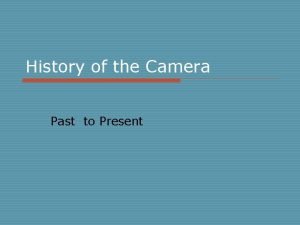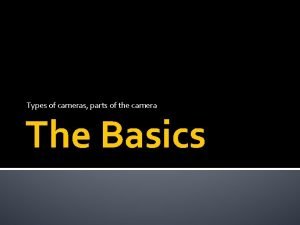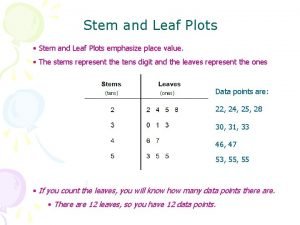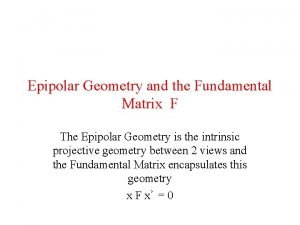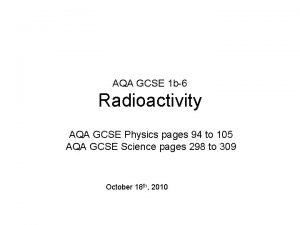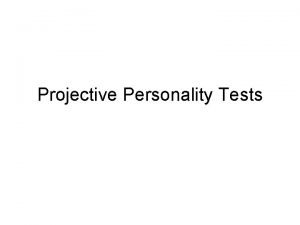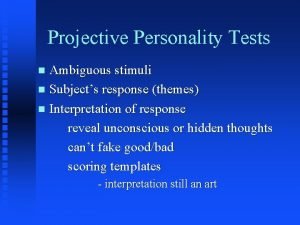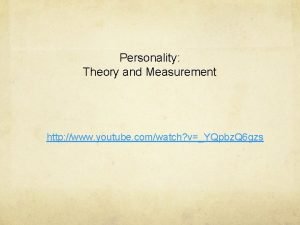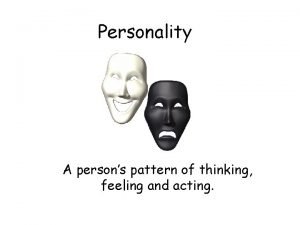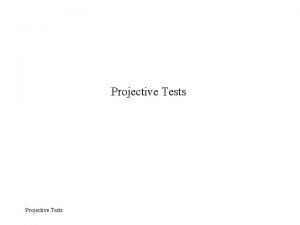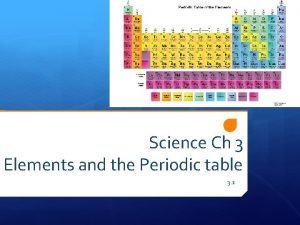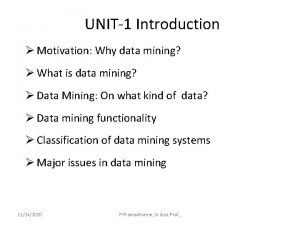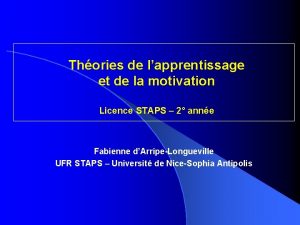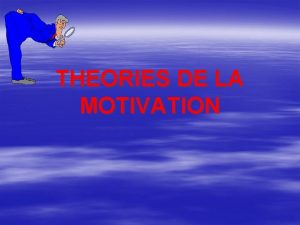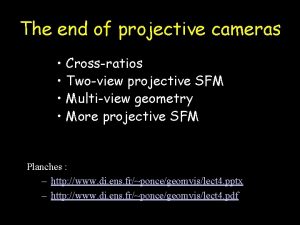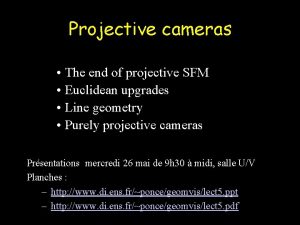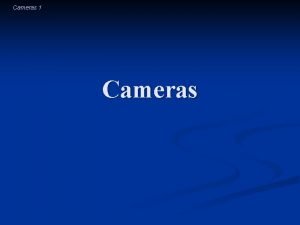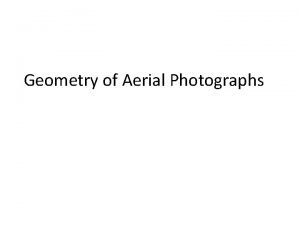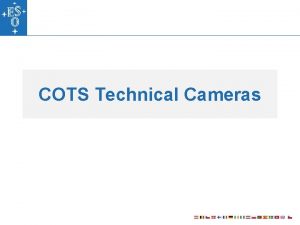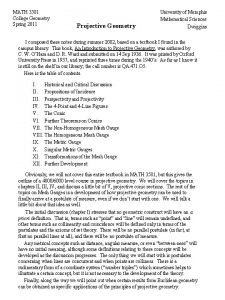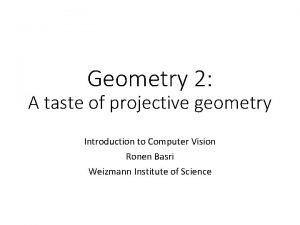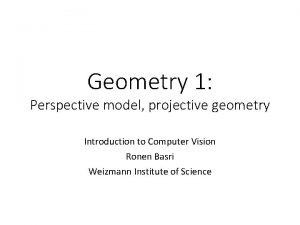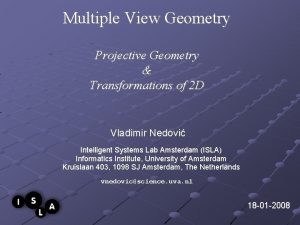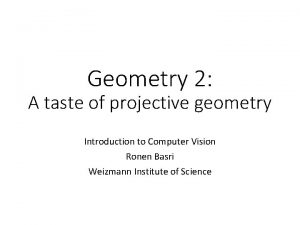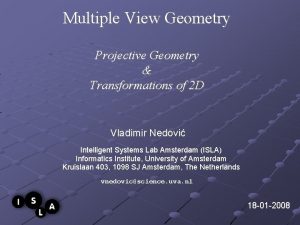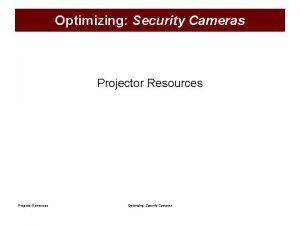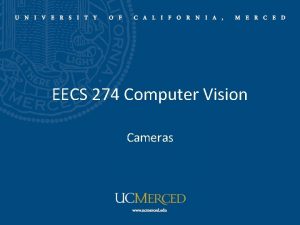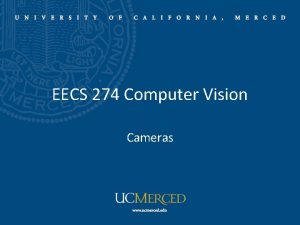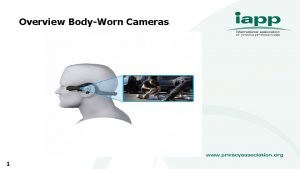Projective cameras Motivation Elements of Projective Geometry Projective





















































- Slides: 53

Projective cameras • Motivation • Elements of Projective Geometry • Projective structure from motion Planches : – http: //www. di. ens. fr/~ponce/geomvis/lect 3. ppt – http: //www. di. ens. fr/~ponce/geomvis/lect 3. pdf

Weak-Perspective Projection Model (p and P are in homogeneous coordinates) r p=MP (P is in homogeneous coordinates) p=AP+b (neither p nor P is in hom. coordinates)

Affine Spaces: (Semi-Formal) Definition

Affine projections induce affine transformations from planes onto their images.

Affine Structure from Motion Reprinted with permission from “Affine Structure from Motion, ” by J. J. (Koenderink and A. J. Van Doorn, Journal of the Optical Society of America A, 8: 377 -385 (1990). 1990 Optical Society of America. Given m pictures of n points, can we recover • the three-dimensional configuration of these points? • the camera configurations? (structure) (motion)

Geometric affine scene reconstruction from two images (Koenderink and Van Doorn, 1991).

The Projective Structure-from-Motion Problem Given m perspective images of n fixed points P we can write j Problem: estimate the m 3 x 4 matrices M iand the n positions P j from the mn correspondences p. ij 2 mn equations in 11 m+3 n unknowns Overconstrained problem, that can be solved using (non-linear) least squares!

The Projective Ambiguity of Projective SFM When the intrinsic and extrinsic parameters are unknown If M i and P are solutions, j So are M’ and P’ where i j and Q is an arbitrary non-singular 4 x 4 matrix. Q is a projective transformation.

Projective Spaces: (Semi-Formal) Definition

A Model of P( R 3 )

Projective Subspaces and Projective Coordinates

Projective Subspaces and Projective Coordinates P Projective coordinates

Projective Subspaces Given a choice of coordinate frame Line: Plane:

When do m+1 points define a p-dimensional subspace Y of an n-dimensional projective space X equipped with some coordinate frame? Rank ( D ) = p+1, where Writing that all minors of size (p+1)x(p+1) of D are equal to zero gives the equations of Y.

Hyperplanes and duality Consider n+1 points P 0, … , Pn-1, P in a projective space X of dimension n. They lie in the same hyperplane when Det(D)=0. This can be rewritten as u 0 x 0+u 1 x 1+…+unxn = 0, or T P = 0, where = (u 0, u 1, …, un)T. Hyperplanes form a dual projective space X* of X, and any theorem that holds for points in X holds for hyperplanes in X*. What is the dual of a straight line?

Affine and Projective Spaces

Affine and Projective Coordinates

Cross-Ratios Collinear points Pencil of coplanar lines {A, B; C, D}= sin( + ) sin( + + )sin Pencil of planes

Cross-Ratios and Projective Coordinates Along a line equipped with the basis In a plane equipped with the basis In 3 -space equipped with the basis *

Projective Transformations Bijective linear map: Projective transformation: ( = homography ) Projective transformations map projective subspaces onto projective subspaces and preserve projective coordinates. Projective transformations map lines onto lines and preserve cross-ratios.

Perspective Projections induce projective transformations between planes.

Projective Shape Two point sets S and S’ in some projective space X are projectively equivalent when there exists a projective transformation y: X X such that S’ = y ( S ). Projective structure from motion = projective shape recovery. = recovery of the corresponding motion equivalence classes.

Epipolar Geometry • Epipolar Plane • Epipoles • Epipolar Lines • Baseline

Geometric Scene Reconstruction F D K I A C J G H E O’’ O’ Idea: use (A, B, C, D, F) as a projective basis and reconstruct O’ and O’’, assuming that the epipoles are known. B

Geometric Scene Reconstruction II Idea: use (A, O”, O’, B, C) as a projective basis, assuming again that the epipoles are known.

Multi-View Geometry • Epipolar Geometry • The Essential Matrix • The Fundamental Matrix

Epipolar Geometry • Epipolar Plane • Epipoles • Epipolar Lines • Baseline

Epipolar Constraint • Potential matches for p have to lie on the corresponding epipolar line l’. • Potential matches for p’ have to lie on the corresponding epipolar line l.

Epipolar Constraint: Calibrated Case Essential Matrix (Longuet-Higgins, 1981)

Properties of the Essential Matrix • E p’ is the epipolar line associated with p’. • E Tp is the epipolar line associated with p. T • E e’=0 and E e=0. • E is singular. • E has two equal non-zero singular values (Huang and Faugeras, 1989).

Epipolar Constraint: Small Motions To First-Order: Pure translation: Focus of Expansion

Epipolar Constraint: Uncalibrated Case Fundamental Matrix (Faugeras and Luong, 1992)

Properties of the Fundamental Matrix • F p’ is the epipolar line associated with p’. • F Tp is the epipolar line associated with p. T • F e’=0 and F e=0. • F is singular.

The Eight-Point Algorithm (Longuet-Higgins, 1981) Minimize: under the constraint 2 |F | =1.

Non-Linear Least-Squares Approach (Luong et al. , 1993) Minimize with respect to the coefficients of F , using an appropriate rank-2 parameterization.

The Normalized Eight-Point Algorithm (Hartley, 1995) • Center the image data at the origin, and scale it so the mean squared distance between the origin and the data points is 2 pixels: q = T p , q’ = T’ p’. i i • Use the eight-point algorithm to compute F from the points q i and q’i. • Enforce the rank-2 constraint. • Output T TF T’.

Data courtesy of R. Mohr and B. Boufama.

Without normalization With normalization Mean errors: 10. 0 pixel 9. 1 pixel Mean errors: 1. 0 pixel 0. 9 pixel

Trinocular Epipolar Constraints These constraints are not independent!

Trinocular Epipolar Constraints: Transfer Given p and p , p can be computed 1 2 3 as the solution of linear equations.

Trifocal Constraints

Trifocal Constraints Calibrated Case All 3 x 3 minors must be zero! Trifocal Tensor

Trifocal Constraints Uncalibrated Case Trifocal Tensor

Trifocal Constraints: 3 Points Pick any two lines l 2 and l 3 through p 2 and p 3. Do it again. T( p 1 , p 2 , p )=0 3

Properties of the Trifocal Tensor T i • For any matching epipolar lines, l 2 G 1 l 3= 0. • The matrices G i are singular. 1 • They satisfy 8 independent constraints in the uncalibrated case (Faugeras and Mourrain, 1995). Estimating the Trifocal Tensor • Ignore the non-linear constraints and use linear least-squares a posteriori. • Impose the constraints a posteriori.

T i For any matching epipolar lines, l 2 G 1 l 3= 0. The backprojections of the two lines do not define a line!

Multiple Views (Faugeras and Mourrain, 1995)

Two Views Epipolar Constraint

Three Views Trifocal Constraint

Four Views Quadrifocal Constraint (Triggs, 1995)

Geometrically, the four rays must intersect in P. .

Quadrifocal Tensor and Lines

Scale-Restraint Condition from Photogrammetry
 Absolute conic
Absolute conic Camera in the past and present
Camera in the past and present Speed detection of moving vehicle using speed cameras
Speed detection of moving vehicle using speed cameras Pinhole camera advantages and disadvantages
Pinhole camera advantages and disadvantages Stem leaf diagram
Stem leaf diagram Jacobs cameras
Jacobs cameras Fundamental matrix
Fundamental matrix Gamma cameras bbc bitesize
Gamma cameras bbc bitesize Pf3 number of vsepr electron groups
Pf3 number of vsepr electron groups 4 electron domains 2 lone pairs
4 electron domains 2 lone pairs Covalent bond order
Covalent bond order Fixation defense mechanism
Fixation defense mechanism Projective test psychology definition
Projective test psychology definition Personality test
Personality test Tests that present ambiguous stimuli
Tests that present ambiguous stimuli The projective hypothesis suggests that _____.
The projective hypothesis suggests that _____. Oral stage
Oral stage Rorschach test meanings
Rorschach test meanings Bad breast theory
Bad breast theory Retrospective labeling definition sociology
Retrospective labeling definition sociology Exploratory design
Exploratory design Undoing defense mechanism examples
Undoing defense mechanism examples Pychology test
Pychology test Projective test ap psychology definition
Projective test ap psychology definition Intuitive projective faith
Intuitive projective faith Qualitative research procedures
Qualitative research procedures Site:slidetodoc.com
Site:slidetodoc.com Projective monitor
Projective monitor Publicité mécaniste
Publicité mécaniste What is projective listening
What is projective listening Strengths of focus groups
Strengths of focus groups Strength and weakness of psychodynamic approach
Strength and weakness of psychodynamic approach Projective hypothesis
Projective hypothesis Projective techniques of data collection
Projective techniques of data collection Personality test greek
Personality test greek Drama literary elements
Drama literary elements Oracle landed cost management
Oracle landed cost management Hydrosulfuric acid
Hydrosulfuric acid Http //elements.wlonk.com/elements table.htm
Http //elements.wlonk.com/elements table.htm Elements of a folktale
Elements of a folktale Features and themes of african folktales
Features and themes of african folktales Zürcher modell der sozialen motivation
Zürcher modell der sozialen motivation Agency theory of motivation
Agency theory of motivation Work improvement team
Work improvement team Motivation based on ideas of right and wrong
Motivation based on ideas of right and wrong How to define motivation
How to define motivation Gardner's motivation theory
Gardner's motivation theory Motivation and importance of data mining
Motivation and importance of data mining Gilchrist and nesburg study of motivation
Gilchrist and nesburg study of motivation Motivation introjectée
Motivation introjectée Théorie de taylor sur la motivation
Théorie de taylor sur la motivation Nature of work motivation
Nature of work motivation Protection motivation theory
Protection motivation theory Pontius pilate meaning in the crucible
Pontius pilate meaning in the crucible

